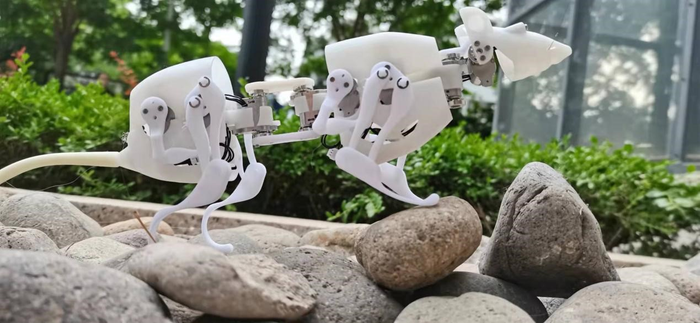
A team of scientists from the Beijing Institute of Technology has developed a small four-legged robot, modelled on a rat, that can perform multiple motions in narrow spaces.
The operation of legged robots in narrow spaces has proven to be challenging. While large quadruped robots have shown excellent adaptability and load capacity, they are unable to enter narrow spaces. Micro quadruped robots, on the other hand, can enter narrow spaces but are unable to perform tasks due to their low payload capacity.
In order to solve this enduring problem, several groups have looked to nature – in particular to cave-inhabiting rats, which exhibit unrivalled agility and adaptability. Having previously developed a wheeled robotic rat capable of multiple rat-like behaviours, a team led by Professor Qing Shir recently replaced the wheels with legs to further enhance the robot’s agility. The team’s experimental results reveal that the legged robot, dubbed SQuRo (small-sized quadruped robotic rat), is capable of mimicking the motion of actual rats inside narrow spaces.
The team first extracted the key movement joints of rats and completed a degree of freedom (DOF) configuration for each. Specifically, they designed two DOFs in each limb in order to reproduce the rats’ limb movement, two DOFs in the waist and two DOFs in the head to replicate the flexible spine movement. They then provided SQuRo with a long, flexible spine so that it can bend its body and quickly turn around.
In addition to copying the morphology of rats, the team also set out to replicate their locomotive characteristics. To this end, they proposed a hierarchical open-loop controller to achieve multimodal motion similar to that of rats. The control framework mainly consists of three layers: a multi-motion planner with four basic motion modes; parameter optimisation, with the consideration of the stability and actuation limits; and trajectory generation for each joint. This control framework made it possible for the robot to undertake agile movements and rapid transitions.
SQuRo can perform a variety of movements, including crouching-to-standing, walking, crawling and turning, and can recover after falling by controlling its limbs and cervical parts to appropriately adjust its centre of mass. In field tests, SQuRo successfully passed through an irregular narrow passage with an inner width of 90 millimetres, crossed an obstacle with a height of 30 millimetres and achieved stable locomotion on a slope with an inclination of 15°, which demonstrates its potential application for inspection tasks inside narrow spaces.
Compared with state-of-the-art quadruped robots of a similar scale, SQuRo has a more elongated, slimmer body and reduced weight. The minimum turning radius of 0.48 body length is much smaller than that of other robots. Moreover, SQuRo can achieve steady locomotion even while carrying a load equal to 91 per cent of its own weight, which is superior to the capacity of other small quadruped robots.
The research has been published in IEEE Transactions on Robotics.



